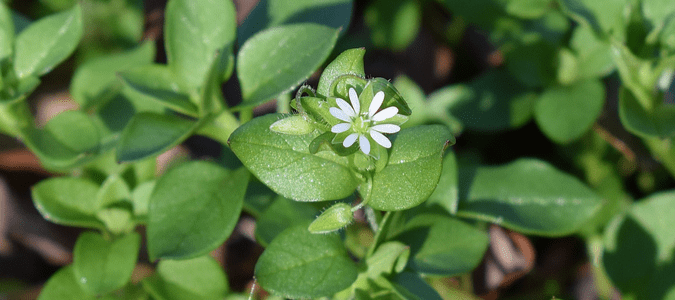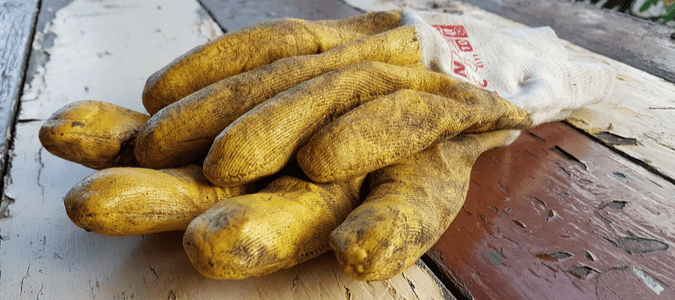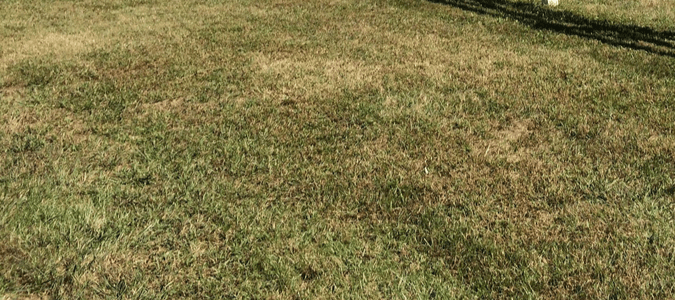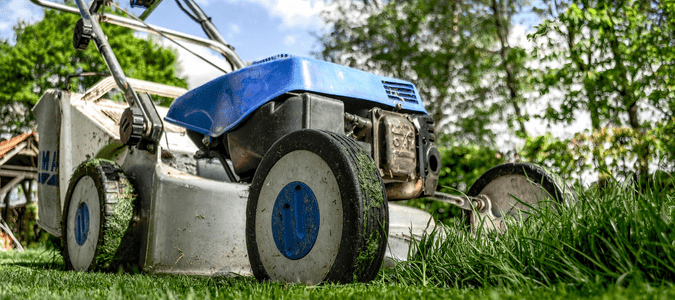
As summer draws to a close and fall begins, a big part of your lawn maintenance will involve getting ahead of the winter weeds. As your grass becomes dormant, it’s important to take steps to prevent heartier varieties of weeds from taking hold once colder temperatures set in. Being able to identify the different types of winter weeds in Texas can help you identify and get rid of any of these unsightly plants before they take over your lawn.
The most common winter weeds us Texans have to look out for are chickweed, henbit and annual bluegrass.
Chickweed
Chickweed isn’t just a weed; it’s also an edible plant. This species actually got its name because chicks, as well as other foul, love to eat it. However, unless you have chickens who will keep this weed from spreading across your lawn, you’ll want to control this bothersome plant as quickly as you can.
Chickweed is distinct because of its thin spatula- or egg-shaped leaves that have no stem, and tiny individual white blooms whose petals have a slight notch at the end. Additionally, while this Texas winter weed may have stems that shoot up, these plants typically spread outward along the ground with roots at each node.
Henbit
You can identify henbit by its square stem, ovular triangle-shaped leaves and sparse hairs that point downward. If left to grow, these plants produce clusters of reddish-purple flowers.
This common Texas winter weed is considered a dead-nettle and got its name because hens seem to like it. Henbit is a relative of mint and it’s actually perfectly safe for humans to eat. However, unless you’re a fan of foraging or have purposefully planted this species in a pot to attract local pollinators, you’ll find that henbit can be incredibly invasive.
Annual Bluegrass
Annual bluegrass, or Poa annua, doesn’t really pose much of a problem to most other flora you might have in your landscape. That said, this plant is often considered aesthetically unappealing.
While there is nothing “blue” about this grass (despite what the name might otherwise suggest), you can easily identify bluegrass by individual clumps in your yard. This plant is also usually brighter than the rest of your grass, and if it grows high enough, you’ll notice white feathery seed heads that might remind you of wheat. The primary concern with this winter weed variety is its tendency for prolific reproduction and spread once established.
Now that you may have identified the weed that you’re dealing with, the next questions you probably have are how to prevent these weeds and what can you do to eliminate them from your yard if they’ve already rooted. Your first step in preventing winter weeds will be to apply pre-emergent.
But, what if you aren’t exactly sure what a pre-emergent is and when you should be using it? We’ll explore those topics and other subjects related to winter weeds below.

When To Apply Pre-Emergent In Texas
Here in Texas, the ideal timing for applying pre-emergent for winter weeds is dependent on whether you live in the northern or southern part of the state. Generally speaking, those in the southern half of the state should apply pre-emergent in the beginning of September, and those in the northern half should apply pre-emergent in the middle of September. Many homeowners (and even landscaping pros) actually re-apply again six to eight weeks after the first application to improve their chances for success. If you’re feeling hesitant about your pre-emergent schedule, you can always rely on a professional to help with a schedule, or to even perform the application for you. If you go the do-it-yourself route, keep in mind that it’s better to apply on the earlier side rather than too late. But, why is that?
Pre-emergents are substances that create a barrier at the top layer of soil. They are formulated to coat weed seeds, preventing them from growing shoots or roots. Essentially, a pre-emergent is designed to prevent weeds from emerging from the ground in the first place. While pre-emergent herbicide can be an effective tool in your weed management arsenal, by definition, it is something that can only kill weeds before they have emerged from the ground. Therefore, it’s better to apply pre-emergent early so it can be effective at targeting seeds before they have started to sprout.
When pre-emergent is not applied early enough—or correctly—you can still end up with weeds in your lawn. If you find yourself in this situation, you may be interested in trying some home remedies to get rid of these bothersome plants before calling in the pros.

What Kills Weeds Permanently That You Already Have?
If you’re an avid gardener, you may know a few common household items that homeowners have used to kill weeds: white vinegar, table salt and dishwashing liquid.
Distilled White Vinegar (5%): Best For Small Sprouts
Vinegar is what’s known as a “burndown” herbicide, which means it works on contact. If you want to try vinegar on your weeds, pour it into an ordinary spray bottle and give individual weeds a couple of spritzes each. The active ingredient, acetic acid, will kill the visible parts of weeds in a few hours to a few days. Keep in mind that with this method only small, tender sprouts are likely to disappear, so this will be less effective on more established plants.
Table Salt: For The “Root” Of Your Problems
Getting to the “root” of your problem with more established weeds may take more work, and some gardeners swear by table salt. Before you try this, though, we want to issue the warning loud and clear: proceed with caution. When you utilize large quantities of salt, you risk contaminating your soil. Salt dehydrates all plants, disrupting their water balance and compromising them at a cellular level.
If you’d like to try this method, use a small funnel to pour a 3 parts water and 1 part salt mixture directly onto the plant you want to focus on. For this mixture, make sure you go with the most basic salt you can find. Sea salt, rock salt and other “nicer” salts usually aren’t as effective. Additionally, you’re going to want to immediately water any nearby vegetation that your solution may inadvertently reach through the soil to prevent nearby beneficial plants from becoming damaged.
All-Natural Liquid Dish Soap: Another Tactic
Dish soap acts as a binder and dissolves the protective oils and waxes on weeds. Essentially, putting a few drops in either mixture already described allows for vinegar and salt to better adhere to the parts of the weed they are meant to kill.
Quite simply, when liquid dish soap is involved, vinegar is more effectively able to dry out a plant’s leaves, and salt is more easily absorbed by a plant’s roots. In both cases, the weed has a harder time make food, sometimes causing it to die.
There is a wide variety of recipes available using these three ingredients together. Just keep in mind that it will likely take many applications of these household items before you see success, so make sure you’re using them weekly, if not biweekly.
If you find these methods are not effective, if you don’t have the patience for these methods or if you need help with a larger patch of weeds, you have some other options for weed control.

Other Methods For Killing Large Patches Of Weeds
While you do have a couple of options when it comes to killing large patches of weeds in your lawn, some of these interventions are more difficult and time-consuming than others. For example, one way you can kill large patches of weeds is by ceasing the use of your sprinklers entirely. Of course, this can be somewhat difficult in the winter, as you can’t control when there will be natural moisture on your lawn in the form of rainfall.
Another way you can kill large patches of weeds, but which will unfortunately also kill other plants nearby, is by buying a weed barrier. A weed barrier is a large piece of cloth or plastic that you can you place over weeds to deprive them of any sunlight, thereby starving these plants of needed nutrients. A more labor-intensive method to remove large patches of weeds is by using gardening tools to pull out big groups of weeds at a time. However, if you don’t already own a weed barrier or gardening tools, both of these methods will require a trip to the home improvement store and may require a lot of your weekend.
Some homeowners try using heat to kill large patches of unwanted plants. One way to do this is by taking a pot of boiling hot water and pouring it on the weeds. As with many of the other techniques we’re already discussed, this approach can take significant time and energy, and you may opt instead to hire a lawn services company to handle the issue year-round.
In addition to applying pre-emergent and eliminating any sprouting weeds, there some other things homeowners can do to prepare for spring.

A Few More Spring Landscaping Tips
Once you’ve made it through another winter weed season successfully, you’ll need to prepare your yard for spring and summer. Below are a few landscaping tips to get you started on your outdoor “spring cleaning”:
- Rake up the loose brown matter that has accumulated over the cold season.
- Apply post-emergent (with caution) to continue your lawn’s winter weed protection.
- Add fresh mulch to those areas of your garden that seem to have dried out.
- Seed areas of your lawn that have died.
- Once your grass has grown enough to mow a couple of times, consider hiring a landscaping company to fertilize and aerate your lawn for the spring.
- Examine your trees for any dead or diseased limbs that can be removed by a professional.
Once you’ve taken these steps to clean up your yard after winter, you’re ready to get into full swing with your spring gardening. And then before you know it, you’ll be wondering how to keep your lawn green in summer heat.
ABC Can Keep Your Lawn Beautiful Year-Round
Ultimately, every weed has a survival strategy. Seeds may lie dormant for several seasons before the right conditions present themselves for germination. Additionally, even the best-laid landscape plans are subject to the whims of the wind, water and animal activity in your area. Keeping your landscape looking great and weed-free takes year-round work. Thankfully, the pros at ABC Home & Commercial Services have been helping homeowners all over Texas keep their lawns lush, green and weed-free for decades. With the help of our pros, you won’t have to worry about unsightly weeds in your lawn during winter, or any other time of year.